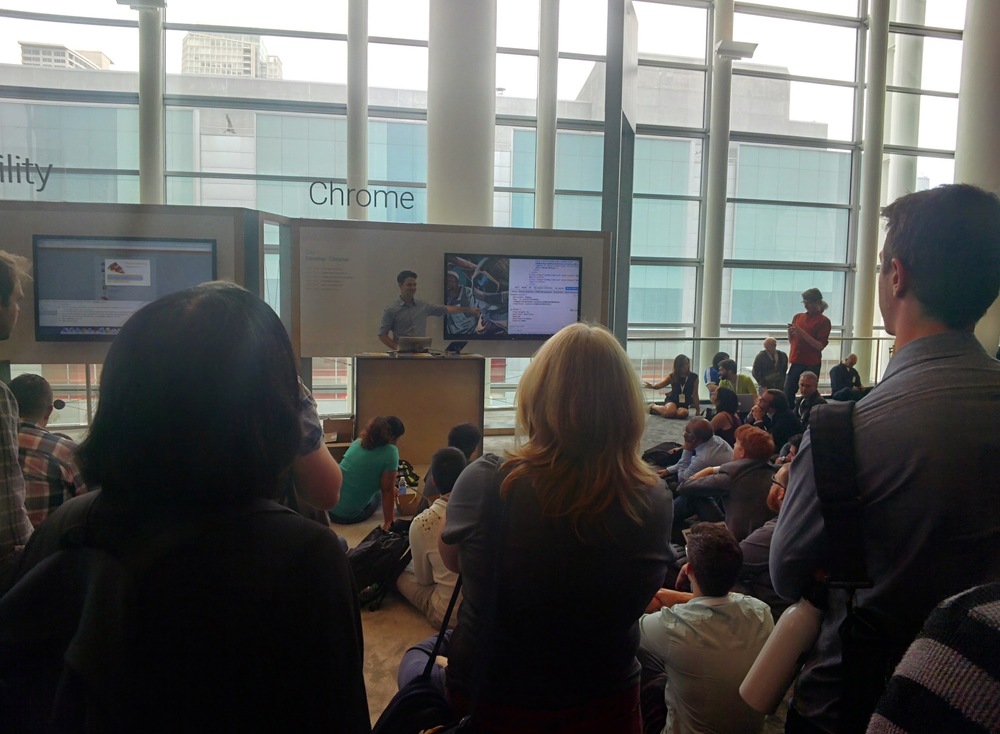I had no intention of going to I/O this year. I put my name in the hat and didn’t get picked. No big deal, life goes on. Then a few changing circumstances later, I had a ticket and off I was to I/O for year number three.
The good: doing code reviews
My goals in the past have been pretty simple when attending: talk to the people building the products, apis and architectures that I use to ship code and product. This year, I took a slightly different approach and tried to help talk people through there own development issues, primarly on Glass and Chrome/Web development. This worked out really well actually and I was able to meet some folks I’ve only spoken with online in person. Sadly, I wasn’t able to sit down with everyone, but I tried to reach out to as many folks who reached out before I/O as I could.
The really good: sandboxes
This year, the develop sandboxes on the second floor had some great talks that sadly don’t appear to have been recorded. They were very real time in nature (Paul Irish doing real time jank busting is thing of magic and beauty) and overall the one’s I stood in on were very to the core nitty gritty stuff. Jake Archibald’s obscure browser behavior quiz was fantastic (I maintain he deserves his own show).
Many of the other sandboxes were equally deserving of everyone’s time. The Go sandbox had some great content and the Cloud platform folks were deploying left and right on the fly. For myself, the sandboxes were the place to be.

The tenacity: real time demos
I’m a huge fan of the real time demo. I like using them in my talks whenever possible as I feel it solidifies the concept for most folks.
So many talks be it streamed or otherwise relied on real time demos. Many failed at the hands of tapped out wifi (I’m positive I never was able to send data on the wifi), but that didn’t stop the tenacidy of the developers presenting from trying they’re damnedest to make it work. Watching Alex Rusell and Jake Archibald push hard to make their ServiceWorker talk demo work was both comic gold but also showed the deep passion they have: they wanted to prove this worked. And they succeeded.
Speaking of ServiceWorker, it’s going to be great. I know I sound like a broken record and ServiceWorker may not be perfect, but it will greatly level the playing field for the web when it comes to installable, offline web applications in comparision to their native kin.
The awesome: more women
It’s no secret that my oldest daughter is into two things: piano and building robots. When you’re an eight year old girl that likes to build robots, this can raise unneccesary eyebrows from people who think that is not an appropriate activity for an eight year old girl. I’ve taken her to Google in the past and she’s gotten a chance to meet women in tech. She’s met women in science (my wife is a wildlife biologist by trade). But even through those experiences, it’s a long row to hoe.
Hence, I was quite glad to see a greater number of women at I/O this year. I can only hope this signals further inclusion of women not only at I/O but throughout the industry. Maybe I’m selfish, but I’d like my three daughters to have every opportunity.
The confused masses: where-is-glass and where-is-the-web
I heard and further read online after the conference ended that a lot of folks where greatly concerned that the keynote did not have a great deal of information on Glass and the web in general.
I didn’t put much stock in these view points. There were lots of talks on the web on both days and there was a whole design sprint for Glassware on Thursday. Along the same lines, there was a fantastic talk on some of Glass by P.Y. Laligand and Hyunyoung Song which showed off some really interesting development with Glass.
Similarly, it wasn’t like you couldn’t find the Chrome or Glass team members. Only thing you had to do was look around and be patient. Everyone was they’re usual nice selves.
So my response: breathe. The web is not going away nor is Glass. Keep writing great code, keep building amazing experiences.
The ugly: crowd control
I missed half the keynote due to crowd control being a nightmare. Significantly worse than in my previous attendance. While the sessions where spaced out more, this also seemed to get me run into signifcantly more. Not in the “hey how you doing?” way, but more of the “I’m running you over to try to get to the free thing line!”.
It’s 6000+ people. It’s going to be tight lanes. :-)
Wrapping up
I’m sure there is a great deal I missed, but overall I felt the conference content was well done. If there was one takeaway, I’d say that the horizens of what is possible within Google’s stack of technologies only continues to grow to fit the needs of developers looking to ship highly scalable applications.